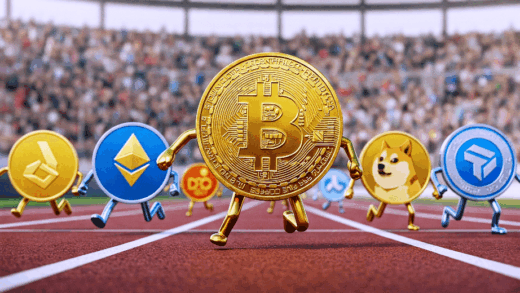Since Bitcoin’s debut in 2009, cryptocurrencies have evolved from a niche experiment to a multi-trillion-dollar asset class. Known for their technological innovation and potential for extraordinary returns, digital currencies have created a new generation of crypto millionaires and redefined wealth creation.
Understanding the historical performance of leading cryptocurrencies offers insights into the patterns, technologies, and market forces behind their success. This analysis reviews the top 10 cryptocurrencies by lifetime returns, highlighting key milestones and innovations—from Bitcoin’s digital gold status to Ethereum’s smart contracts and the viral rise of meme coins like Dogecoin.
While past performance doesn’t predict future outcomes, examining the rise of these top-performing assets offers valuable context for navigating the fast-changing crypto landscape.
The Cryptocurrency Revolution: A Brief History
Bitcoin, launched by the pseudonymous Satoshi Nakamoto in 2009, introduced blockchain technology—a decentralized ledger that removed the need for intermediaries. Initially worth mere pennies, Bitcoin eventually surpassed $100,000, catalyzing a wave of alternative cryptocurrencies.
Ethereum, introduced in 2015, added smart contracts—code-based agreements—making blockchain programmable. Other notable entries followed: XRP for cross-border payments, Binance Coin as a utility token, and projects like Cardano and Solana targeting scalability and energy efficiency.
Cultural and community dynamics also shaped the market. Dogecoin, launched as a joke, became a serious asset due to its online following. Meanwhile, institutional adoption accelerated, with payment giants, investment firms, and even El Salvador embracing crypto. These milestones marked a shift from fringe tech to mainstream finance.
Challenges like regulation, security, and sustainability persist, but the industry has shown resilience—evolving through proof-of-stake, layer-2 solutions, and increased compliance.
Methodology
This ranking is based on the percentage gain from each cryptocurrency’s launch price to its value as of May 2025, using the earliest reliable price data available.
To ensure relevance, we included cryptocurrencies with:
- A market cap over $5 billion
- Consistent trading activity
- At least two years of history
Data was sourced from CoinMarketCap, CoinGecko, and verified through multiple platforms. Year-over-year returns were taken from Forbes Advisor. Where inconsistencies arose, we prioritized the most authoritative sources.
Note: Cryptocurrency prices are highly volatile. This snapshot reflects data as of May 19, 2025 and is intended for informational purposes—not investment advice.
Top Cryptocurrencies by Market Cap (May 2025)
| Rank | Cryptocurrency | Symbol | Launch Date | Initial Price | Current Price | Market Cap (USD) | Percentage Gain | Year-over-Year Return |
|---|---|---|---|---|---|---|---|---|
| 1 | Bitcoin | BTC | Jan 2009 | $0.0008 (2010) | $103,427.81 | $2.05T | ~129,284,762% | 52% |
| 2 | Ethereum | ETH | Jul 2015 | $0.311 | $2,394.71 | $289.1B | ~770,003% | -42% |
| 3 | Binance Coin | BNB | Jul 2017 | $0.10 | $639.84 | $90.1B | 639,740% | 3% |
| 4 | Shiba Inu | SHIB | Aug 2020 | $0.000000000082 | $0.00001436 | $8.5B | 17,512,095% | N/A |
| 5 | XRP | XRP | 2012 | $0.0058 | $2.35 | $138.2B | 40,417% | 349% |
| 6 | Dogecoin | DOGE | Dec 2013 | $0.0002 | $0.2204 | $32.9B | 110,100% | 26% |
| 7 | Solana | SOL | Mar 2020 | $0.77 | $166.39 | $86.5B | 21,609% | 9% |
| 8 | TRON | TRX | Sep 2017 | $0.0019 | $0.2624 | $24.9B | 13,710% | 109% |
| 9 | Chainlink | LINK | Sep 2017 | $0.11 | $15.22 | $10.0B | 13,736% | N/A |
| 10 | Cardano | ADA | Sep 2017 | $0.02 | $0.7291 | $25.8B | 3,546% | 57% |
*Note: Data as of May 19, 2025. Initial prices represent earliest reliable recorded values. Percentage gains calculated from initial price to current price.*
Bitcoin, launched in 2009 by Satoshi Nakamoto, is the first decentralized digital currency and the most profitable long-term crypto investment. From a starting value of $0.0008, it surged to over $103,000 by May 2025—nearly a 130 million percent return. Its capped supply of 21 million coins fuels scarcity, earning it the nickname “digital gold.” Institutional adoption, national integrations (e.g., El Salvador), and retail acceptance have bolstered its rise. Despite crashes exceeding 80% in 2014 and 2018, Bitcoin consistently rebounds to higher price floors. It commands over 60% of the $3.3 trillion crypto market, valued at $2 trillion, maintaining its role as the primary benchmark. Key concerns include regulatory scrutiny, environmental impact from proof-of-work, and competition from CBDCs and newer blockchains. However, its first-mover advantage, unparalleled security, and brand recognition keep Bitcoin firmly positioned as the cornerstone of the cryptocurrency ecosystem. Ethereum, created by Vitalik Buterin in 2015, revolutionized blockchain by introducing smart contracts, enabling decentralized apps (dApps) and forming the backbone of DeFi and NFTs. Priced at $0.311 during its ICO, ETH rose to $2,394 by May 2025—a 770,003% gain. Unlike Bitcoin, Ethereum acts as a decentralized “world computer” with ETH used to fuel network operations. Major milestones include the 2022 transition from proof-of-work to proof-of-stake (“The Merge”), slashing energy use by 99% and boosting scalability. While facing competition from faster networks, Ethereum retains dominance in total value locked, developer activity, and ecosystem diversity. Despite a 42% price drop year-over-year, ETH remains the top smart contract platform, supported by strong network effects and continuous innovation. Its programmable nature and active community solidify its role as a technological pioneer and essential infrastructure in the blockchain space. Binance Coin (BNB), launched in 2017 at $0.10, has surged to $639.84 by May 2025, delivering a 639,740% return. Initially an ERC-20 token for fee discounts on Binance, it evolved with the launch of Binance Chain and BNB Chain, becoming the native token of a blockchain supporting DeFi and dApps. Binance’s massive growth as the world’s largest crypto exchange fueled BNB’s success, further enhanced by regular token burns that reduce supply. With a market cap over $90 billion, BNB ranks among the top five cryptocurrencies. Despite modest 3% gains year-over-year, it reflects post-rally consolidation. Unlike many tokens lacking utility, BNB’s value is tightly linked to Binance’s expansive services, creating a feedback loop between business growth and token performance. Its role in staking, trading, and governance within the Binance ecosystem underscores BNB as a prime example of a utility token achieving exceptional long-term returns. XRP, created by Ripple Labs in 2013, was designed for fast, low-cost cross-border payments, diverging from Bitcoin’s decentralized vision. Initially priced at $0.0058, XRP reached $2.35 by May 2025—a 40,417% gain. It facilitates instant settlements between banks, offering an energy-efficient alternative to traditional systems. XRP has faced volatility, peaking above $3 in 2018 before long declines, but rebounded strongly with a 349% year-over-year increase in 2025, buoyed by Ripple’s legal victory over the SEC in 2023. Ripple retains influence through its escrow holdings and governance of the XRP Ledger, raising decentralization concerns but enabling swift development. With a $138 billion market cap, XRP remains a top-10 cryptocurrency. Its speed, low fees, and strategic partnerships with financial institutions position it as a bridge between traditional finance and blockchain, proving that targeted utility can yield long-term success in the digital asset space. Dogecoin, created in 2013 as a joke, has defied expectations by reaching $0.2204 in May 2025 from a starting price of $0.0002—a 110,100% return. Based on Litecoin, it features quick block times and an unlimited supply, adding 5 billion DOGE annually. Despite its inflationary design, Dogecoin thrives on strong community support and viral cultural relevance. It became a symbol of inclusiveness, sponsoring causes like clean water and sports teams. Its popularity soared with backing from Elon Musk, who dubbed himself the “Dogefather” and amplified the coin’s exposure via social media and television. Dogecoin’s market cap now exceeds $33 billion, with a 26% year-over-year gain in 2025. Its continued success, despite lacking advanced tech features, highlights the power of branding and community in crypto markets. Dogecoin’s legacy paved the way for meme coins and proved that digital assets can succeed on culture and engagement alone.
Launched in March 2020, Solana has delivered returns of 21,609%, growing from $0.77 to $166.39 by May 2025. It aims to solve blockchain scalability issues through a hybrid consensus model combining proof-of-stake with proof-of-history. This innovation allows for thousands of transactions per second with sub-second finality and fees often below $0.01. Solana has become a top choice for DeFi, NFTs, and gaming. Backed by strong venture capital and an active developer base, the ecosystem has expanded rapidly. Despite early outages and decentralization concerns, recent improvements have boosted stability. With over $86 billion in market cap and 9% annual growth in 2025, Solana stands as a robust Ethereum alternative, particularly strong in consumer-facing applications requiring speed and usability. Its success reflects the demand for high-performance, low-cost blockchain infrastructure as the industry matures. Cardano, launched in 2017 by Charles Hoskinson, emphasizes academic rigor and peer-reviewed development. Starting at $0.02, ADA has grown to $0.7291 by May 2025, yielding a 3,546% return. Built on the Ouroboros proof-of-stake protocol, Cardano prioritizes security and formal verification. Its roadmap includes five structured phases: Byron, Shelley, Goguen, Basho, and Voltaire. While slower to roll out features than competitors, Cardano’s methodical approach has produced a secure and scalable platform. With a market cap of nearly $26 billion and a 57% annual return in 2025, it remains in the top 10 cryptocurrencies. Cardano has gained traction in developing regions, especially Africa, through real-world applications in identity and education. Its focus on sustainability, governance, and social impact distinguishes it from other blockchains, offering a unique value proposition in a fast-moving industry. TRON, launched in 2017 by Justin Sun, targets digital entertainment, boasting a 13,710% return from $0.0019 to $0.2624 as of May 2025. It leverages a delegated proof-of-stake consensus to support thousands of transactions per second at low cost, ideal for gaming and content-sharing apps. TRON’s acquisition of BitTorrent expanded its reach in decentralized file sharing, and its strong presence in Asia drives adoption. The TRON ecosystem includes DeFi applications and strategic partnerships, fueling a nearly $25 billion market cap. Governance is handled by 27 super representatives, sparking decentralization concerns, but enabling high performance. With a 109% return in 2025 alone, TRON has demonstrated strong momentum. Its focus on entertainment and practical utility highlights the value of niche specialization in blockchain, providing creators with new monetization opportunities while attracting millions of users worldwide. Shiba Inu, launched in 2020, delivered astronomical returns of over 17.5 million percent, rising from $0.000000000082 to $0.00001436 by May 2025. Originally a meme token, SHIB was built on Ethereum as an ERC-20 token, facilitating integration with DeFi tools. Half of its initial supply was sent to Vitalik Buterin, who donated and burned the majority. SHIB has since evolved into a broader ecosystem including ShibaSwap, NFTs, and a layer-2 blockchain. Its passionate community, the “SHIB Army,” has driven viral adoption and persistent visibility across social media. With a market cap exceeding $8.4 billion, SHIB remains relevant despite lacking groundbreaking technology. Its story illustrates the market power of community-driven assets, where narrative and culture create tangible market presence. Though speculative, SHIB’s longevity and expansion into DeFi utilities show meme tokens can mature into more functional platforms. Chainlink, launched in 2017, solves the “oracle problem” by connecting blockchains to real-world data. LINK has risen from $0.11 to $15.22 by May 2025, a 13,736% return, with a market cap of $10 billion. Chainlink’s decentralized oracle network enables smart contracts to access external data securely. Node operators stake LINK to ensure reliable performance, making it a foundational layer for DeFi. It supports over $75 billion in value and is integrated across thousands of projects. Beyond price feeds, Chainlink offers verifiable randomness, proof-of-reserve, and cross-chain services. Unlike many tokens, LINK derives value from clear utility. Its critical infrastructure role in DeFi and expanding services make it one of the few cryptocurrencies with demonstrable real-world impact. Chainlink’s success reflects the importance of solving specific, high-value problems in blockchain development. The top 10 highest-returning cryptocurrencies reveal an extraordinary era of innovation, community influence, and rapid market evolution. Bitcoin’s near 130 million percent return, Ethereum’s 770,000% gain, Binance Coin’s 640,000% growth, and Shiba Inu’s unprecedented 17.5 million percent surge showcase wealth creation at a scale unmatched in traditional finance. These numbers reflect more than speculative mania—they highlight genuine breakthroughs in blockchain technology, digital scarcity, and decentralized systems. Each project contributed uniquely: Bitcoin introduced a new form of money; Ethereum pioneered smart contracts; Binance Coin fueled exchange-based ecosystems; and meme coins like Dogecoin and Shiba Inu demonstrated the power of community and cultural relevance. The enduring success of early movers, strong community engagement, and purposeful tokenomics underscore key drivers of sustained growth. As the crypto market matures, exponential gains may become rarer, but innovation continues. Regulatory shifts, scalability advances, and emerging use cases will shape the next chapter. Investors should view past returns with caution, as volatility and uncertainty remain inherent to the space. Still, the core innovation—programmable, permissionless digital value—represents a foundational shift in how we conceive and exchange assets. The performance of these top cryptocurrencies may only mark the beginning of a broader financial and technological transformation.Bitcoin (BTC): The Pioneer
Ethereum (ETH): The Programmable Blockchain
Binance Coin (BNB): The Exchange Token
XRP: The Banking Solution
Dogecoin (DOGE): The Meme Coin Success
Solana (SOL): The High-Performance Blockchain
Cardano (ADA): The Academic Approach
TRON (TRX): The Entertainment Blockchain
Shiba Inu (SHIB): The Dogecoin Competitor
Chainlink (LINK): The Oracle Network
Conclusion










![[Sponsored] STG Energy Launches Breakthrough Cloud Mining Product to Democratize Crypto Mining 10 STG mining](https://coinfunda.com/wp-content/uploads/2025/02/STG-mining-520x293.webp)
![[Sponsored] Centralhash cloud mining platform easily obtains 100,000 US dollars of 11 central hash](https://coinfunda.com/wp-content/uploads/2025/02/central-hash-512x293.webp)